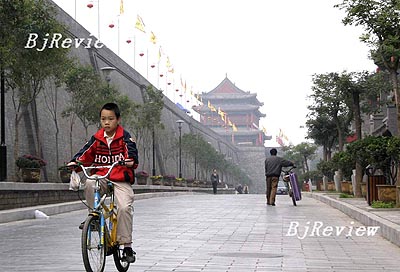|

Xi'an, the provincial capital of Shaanxi Province in central China, is one of the most important cities in the country's history. Under the name of Chang'an, or perpetual peace, it was the longest-serving capital city in China, its reign lasting at least 12 dynasties through the Qin Dynasty (221-206 B.C.), the Han Dynasty (202 B.C.-220), and the Tang Dynasty (618-907). The 3,000-year-old city was also one of the world's largest and most cosmopolitan cities and the gateway to the Silk Road to Central Asia.
Its rich cultural heritage has boosted the city's international fame as a tourist destination. One of the must-sees in China for overseas travelers are the Terracotta Warriors at the mausoleum of Qinshihuang, the first emperor of a unified nation. Despite its glorious past, Xi'an in recent years has lagged behind other big cities in China in economic growth.
As a new measure to revitalize the city, the Xi'an Municipal Government has launched a plan to revive its prime years during the Tang Dynasty, through both cultural development and economic investment.
Using brand value
Although Xi'an's basic Tang Dynasty layout remains and the city's 12-meter high wall is still intact a large part of the old city has been demolished to make way for new development. In most cases modern planners have given little thought to maintaining a harmonious architectural style across the city, and many of the remaining old buildings suffer from poor protection.
A project to halt any further damage to Xi'an's architectural history will begin to properly protect its old buildings. According to Xiang De, Deputy Director of Xi'an Administration of Cultural Heritage, a total of 2,944 registered sites of cultural relics are scattered around the city, of which 41 have been ranked as sites under key state protection.
Xi'an Museum, which was opened on May 18, covers a floor area of only 16,000 square meters, but has collected over 130,000 cultural relics from Xi'an's past. Among this rich collection, 14,400 pieces are classed as cultural heritage under state protection.
He Hongxing, Director of Xi'an City Planning Bureau, said, "The top priority is to protect and preserve the cultural relics, and then we can best exploit their social and economic value."
As for how to get the best value out of historical relics, he said key measures should include exhibiting them to the public and inviting comment. Meanwhile, the city's cultural heritage will be categorized in order to make its management easier.
As part of the plan to rejuvenate the prime of the Tang Dynasty, Xi'an has implemented a plan to rebuild Xi'an's culture and protect streets with rich cultural relics. Concrete measures include better protection for sites of significant cultural relics, the banning of high-rise building in ancient parts of the city, the protection of historical residences and the acceptance of gray as the basic color of the city. According to statistics from the city government, the annual cost for maintaining Xi'an's cultural heritage in recent years has been 50 million yuan.
The city government has also spent huge amounts of money building several historical theme parks, which stage historical performances and exhibitions. These theme parks, good at mixing hi-tech and tradition, have been attracting tourists in droves. According to official statistics, the city received 4.32 million tourists in the first three months of 2007, presenting a year-on-year increase of 11 percent. This growth rate is far higher than the average level for China.
"One guideline for our rejuvenation of the prime of the Tang Dynasty is to exhibit our historical relics and maximize their value," said He.
To reduce population density in the ancient part of Xi'an, the city government has decided to move the government headquarters out of the area. The use of private cars will be limited while the use of bus, electric car and non-motorized vehicles will be encouraged.
Xi'an has also set up a new industrial park dedicated to cultural development industries. In this new industrial park named Qujiang, investment will be injected to found new companies in the culture industry, in the hope of breathing energy into Xi'an's stage performances and exhibitions.
"Xi'an's rejuvenation should start from the rejuvenation of its culture," said He.
Rising on a wasteland
Chanba Ecological District, a new development zone covering an area of 129 square kilometers, is only a 20-minute-drive northeast of Xi'an city proper.
"Two years ago when the construction had just started, there was no road in this area. Now two highways and two railways are across the district," said Ma Zhisheng, an official with the administration committee of Chanba.
In the last two years, Chanba has attracted investment on fixed assets of 2.9 billion yuan. Over 40 projects have broken ground. Infrastructure has been built at such an amazing rate that local people say they can see changes every day.
Before the construction of the development zone, Chanba was the largest garbage site in Xi'an. The two rivers surrounding this area, Chanhe River and Bahe River, after which this district was named, were heavily polluted.
According to Wang Jun, Director of Chanba administration committee, the expansion of Xi'an city proper in recent years has made the pollution in Chanhe River and Bahe River a major barrier to overall city planning. After deliberation, the city government decided on the strategy of building an industrial development zone in the polluted area, using development to curb pollution.
| 